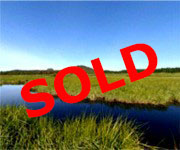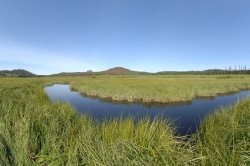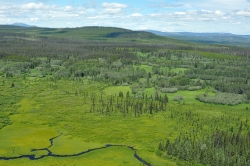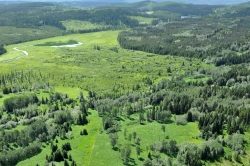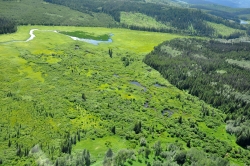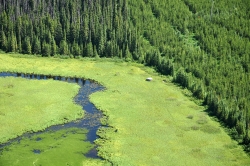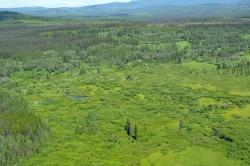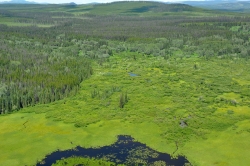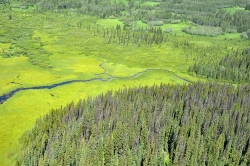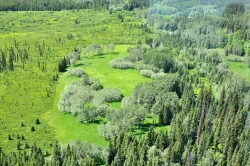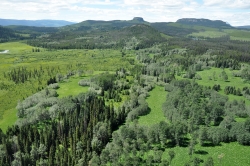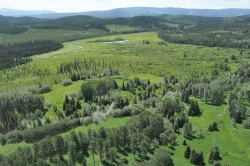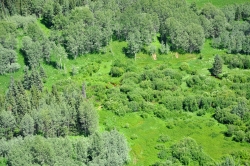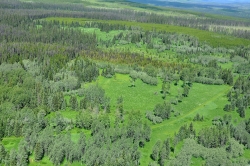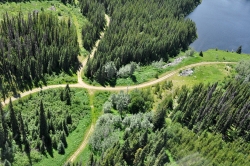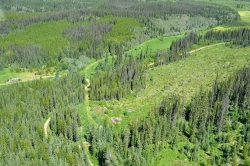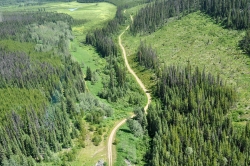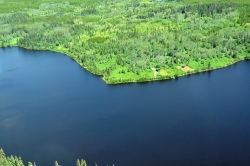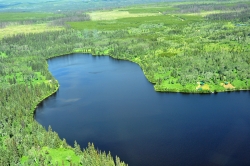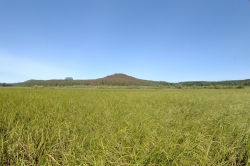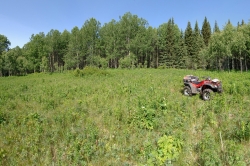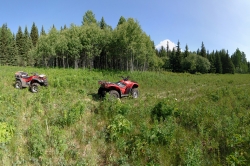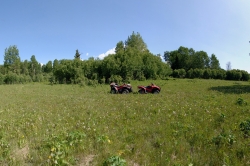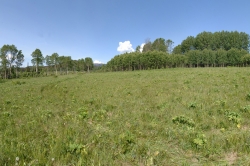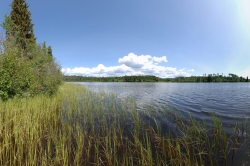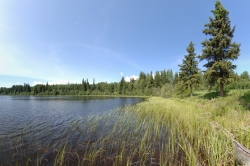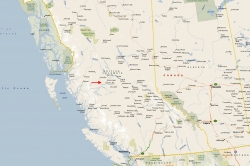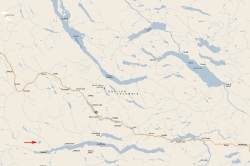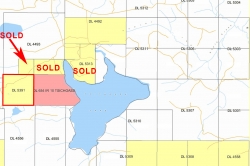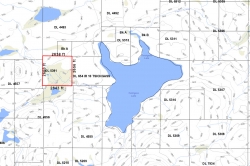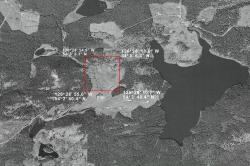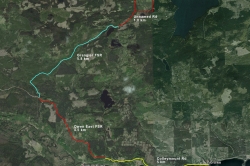Poplar Creek
| Listing Number: | OM52E |
|---|---|
| Size: | 160 Acres |
| Map Reference: | 93L |
| Price: | SOLD |
| Legal: | DL 5391 Range 5 Coast District |
| Description: | This 160 acre property is further back from Tsichgass Lake than some of our other properties. The 60 acre benchland on the northwest section of this property consists of beautiful grassy meadow, with some perfect building sites. The remainder of the property is private wetlands, deep enough for canoe access, depending on the time of the year. This acreage provides you with excellent wildlife viewing and hunting opportunities. There are some scattered stands of aspen and spruce. Tsichgass Lake is about 10,972 m in perimeter, and has a surface area of about 660 acres. Its mean depth is 10.2 metres, although its lowest depth is 18.6 metres. |
| Location: | The property is located close to Tsichgass Lake, about 99 km (61.5 miles) from the Village of Burns Lake. |
| Access: | Driving times to Poplar Creek:
For directions on how to access the property from Vancouver, click here Colleymount Road connects the smaller communities along the north side of Francois Lake to Highway 16. This road is maintained year-round by the Ministry of Transportation and is graded throughout. In the summer it is watered to keep the dust generated by traffic to a minimum. In the winter it is cleared so that traffic can continue using the road. The Forest Service Roads are minimally maintained through the year, but are not generally cleared during the winter. Airport Services The airport at Burns Lake can handle smaller private aircraft and charters. The nearest commercial airport is at Smithers, located about 2 hours away. Regular air service is provided by Air Canada’s Jazz Airlines , Central Mountain Air , and Northern Thunderbird to Vancouver and other points in British Columbia. The Smithers airport expanded its runway and upgrade its operations with federal and provincial funding. Prince George Airport is the regional airport for Northern B.C., and is expected to play a key role in the economic development of the area. The airport has undergone a major expansion, renovating its runways and international cargo plane fuelling capacity. The airport can accept 747 airplane landings and has an International Customs and Canada Border Service area for international charter flights. |
| Recreation: | This property is located close to large tracts of open Crown land, providing public access for horseback riding, quad and ATV driving, and in the winter, snowmobiling. Francois Lake is approx. 110 km (68 miles) long, making it the second largest natural lake in British Columbia. It offers excellent rainbow trout and char fishing. Rainbow trout over 3 pounds and lake trout (char) to over 20 pounds are not uncommon. Water sports of all sorts are popular, with opportunities for boating, kayaking and canoeing. This area has many forest recreation sites, which offer trails for hiking and mountain biking. In the winter ice fishing, cross-country skiing and snowmobiling are popular. Noralee Resort has the only private boat launch on Francois Lake in the area. This popular resort offers heated cabins, camping and RV sites to its guests. Fishermen and campers can also stock up on supplies at their grocery store before heading out. The next closest boat launch is located 9 kilometres (5.6 miles) from the Francois Lake ferry. The closest gas station is at Burns Lake or Houston, an hour’s drive away. Close to this area is North Tweedsmuir Provincial Park, one of the most scenic provincial parks in the province. Tweedsmuir Provincial Park appeals primarily to outdoor recreationists interested in boating, angling, camping, hiking or hunting in one of North America’s most magnificent wilderness areas. Outdoor recreation opportunities are almost unlimited. Parts of the park are open to hunting in the fall. The entire area known as the Lakes District is famous for its excellent fishing and game. There are a number of resorts throughout this area which offer boating, fishing, hiking, horse-back riding, camping, cross country skiing and many other activities. This area is well known for its hunting and wildlife watching opportunities. Black, cinnamon and grizzly bears, deer, moose, wolves, coyotes and eagles can often be observed in the area. Burns Lake is internationally renowned for its mountain biking trails, becoming Canada’s first IMBA Ride Centre (Bronze-level). Since 2006, the Burns Lake Mountain Biking Association has been working with trail professionals to build more than 40 km (25 mi) of singletrack, 20 km (12.4 mi) of downhill trails, and four bike parks. The signature downhill trail—When Pigs Fly— contains more than 100 berms, tabletops, and other features and is accessible by one of the many shuttles run by the local bike shop. In the winter months cross country skiing is very popular at the Omineca Ski Club. Its facilities have hosted several national championships and rank among western Canada’s best trail networks. The facilities include 25 km of groomed trails, four km of which are lit for nighttime skiing. There is also a facility for biathlon skiing. |
| Area Data: | Burns Lake is the nearest community with a population of 3,614 in the village. The first thing that strikes you when you enter this town is the welcoming sign with enormous chainsaw-carved trout and the inscription “Three Thousand Miles of Fishing”. Major industries include forestry and tourism, though many workers commute to jobs in the mining industry. It also serves as the main commercial centre for the surrounding area, offering all retail and financial services, and a newly upgraded hospital (to be completed in 2015). There are many cafes and restaurants, a selection of stores and services, and is location of the head offices of the Regional District of Bulkley-Nechako. In 2014 The Village of Burns Lake completed work on the Lakeside Multiplex and renovations to the Tom Forsyth Memorial Arena. This facility includes a hockey rink, curling rink, rock climbing gym, a squash/racquetball court, a fitness facility, and multi-use rooms. The facility is located on Spirit Square, a large outdoor park with a playground, a beach, a walking path, outdoor fitness equipment, two tennis courts, and a skateboard park. Houston: With a population of 3200 people, the district municipality has been called the ”Steelhead Capital of Canada” as the productive Bulkey and Morice rivers merge here. However, with fishing, boating, hiking, wilderness watching, and other recreational opportunities located within arms reach in Houston, this area is known as an outdoors paradise. Houston’s economy has grown and diversified in recent decades. It has one of the largest wood processing mills in the country and serves as the home community to many of the workers at the Huckleberry copper mine, located 125km south of Houston. Poplar Creek is located within the Lakes District which is noted for sunny skies and moderate rainfall of less than 20 inches per year. This area is known for clean air, friendly people, inviting lakes, wandering country roads, abundant wildlife and the spectacular beauty of nearby Tweedsmuir Provincial Park. |
| History: | Burns Lake is called the “Heart of the Lakes District” and “Gateway to Tweedsmuir Park”. The village takes its name from Michael Byrnes, an explorer in the area who passed by the lake in 1866. Settlers were initially drawn to the area by the promise of gold in the Babine Lake vicinity. The actual village was formed in 1914 to service the workers creating the Grand Trunk Pacific Railway through the area. The arrival of the railway opened the forest industry, drawing more settlers and creating a stable economy for the area. Nearby Francois Lake got its current name by mistake. The Carrier First Nations named the lake Nitapoen Lip Lake because of its shape. The early settlers mistook ‘Nita’ for white man and the lake was named ‘Lac de Francois’ because most of the early settlers at the time were French Canadian voyageurs. During the early years,the local residents pronounced it ‘Francis Lake”, however, it is now known as “Francois Lake”. |
| Vegetation: | This property has aspen and spruce trees. |
| Taxes: | $405.76 (2015) |
| Zoning: | Zoned RR1 (Rural Resource). Agriculture, single, multiple and seasonal dwellings, logging and silviculture, guest ranch, rural retreat, unpaved airstrips and helipads are permitted here. Dwellings on the property are restricted to four seasonal dwellings, two single family dwellings or one two family dwelling. This property is not within the ALR . |
| Sold Date: | 06/10/16 |
